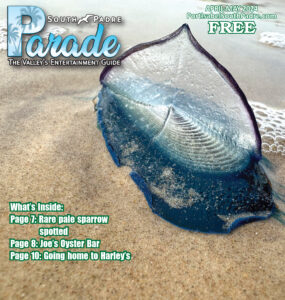By Steve Hathcock
Special to the PARADE
Recently, I received an E-mail from Jean Powers of Minneapolis asking about a sea bean she found while vacationing on South Padre Island. I always like to refer questions of this sort to my friend and partner Kay Lay who identified the find as a Mary’s Bean.
“They are really rather scarce and quite valued by beachcombers,” Kay told me.
“In fact, the Mary’s bean is certainly one of the most elusive and interesting of all drift seeds in fact and fiction. Named after the Virgin Mary, the Mary’s Bean is a distant cousin to the morning-glory family.
“It is also called the crucifixion bean because of a cross etched on one side of the seed. The cross is actually an impression left by the seed when it was attached inside the capsule. The bean is divided into four sections containing one seed each. Internal air pockets keep the bean afloat while a hard woody surface protects the seeds during a journey that can last for years.
“Mary’s beans have been found along the coasts of Central America all the way to Norway. People valued it for its supposed ability to ward off evil spirits. Reputedly, if prepared properly the bean was known to be an antidote for snakebite while hemorrhoid sufferers were told to carry a male and female seed in their back pockets.
“The trees of the rain forest near Golfito, Costa Rica, are bedecked with Mary’s bean vines and several other species of sea beans including the sea heart. The seeds get washed down rivers where they drift out to sea. As a drift seed, the Mary’s bean is known from Wotho Atoll in the Marshall Islands to the beaches of Norway, a total distance of more than 15,000 miles. This is the widest drift range documented for any seed or fruit. Sea beans and Sea hearts may drift as far or farther, but their precise point of origin cannot be determined. The Mary’s bean is unmistakable among drift seeds and its origin is well documented. If you find one, it must have ultimately come from the rain forests of southern Mexico or Central America.”
Like most sea beans and drift seed Mary’s Beans can be found year around on the shores of Padre Island. The best place to look for them is along the “wrack” or high tide line. Occasionally you will find a specimen in a local shell or novelty shop but because they are quite rare be prepared to pay a premium for a quality bean.
For more information about sea beans and drift seeds read “Don’t Pass the Beans” by Kay Lay. Available at Paragraphs Book Store and Cactus Flower on South Padre Island, the gift shop at the Black Dragon Pirate Ship in Port Isabel and other gift and novelty shops in the area.



Comments